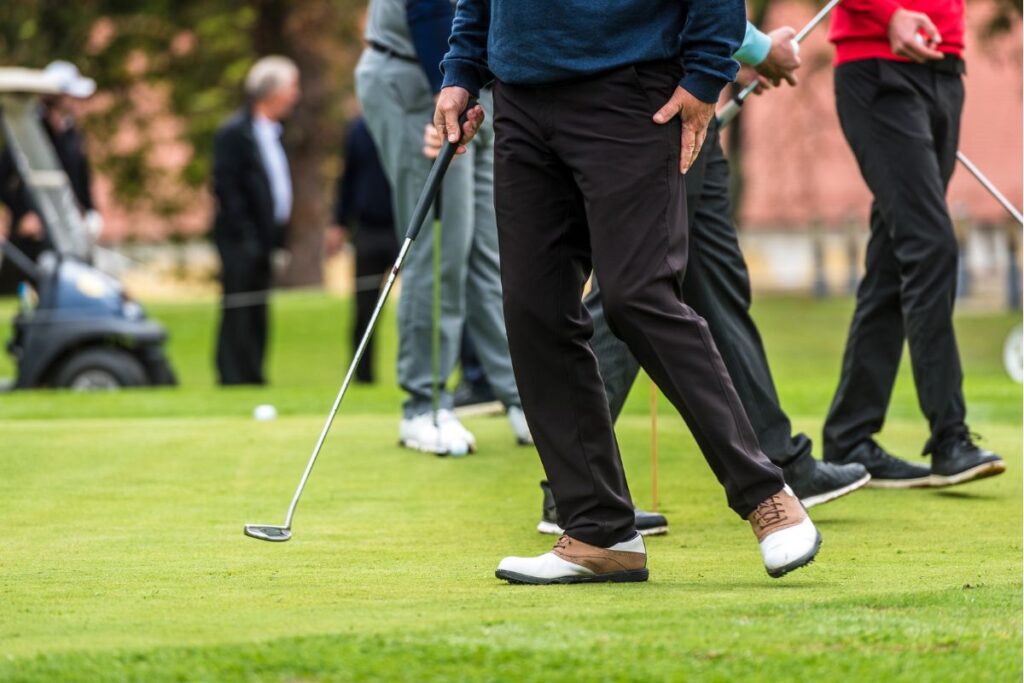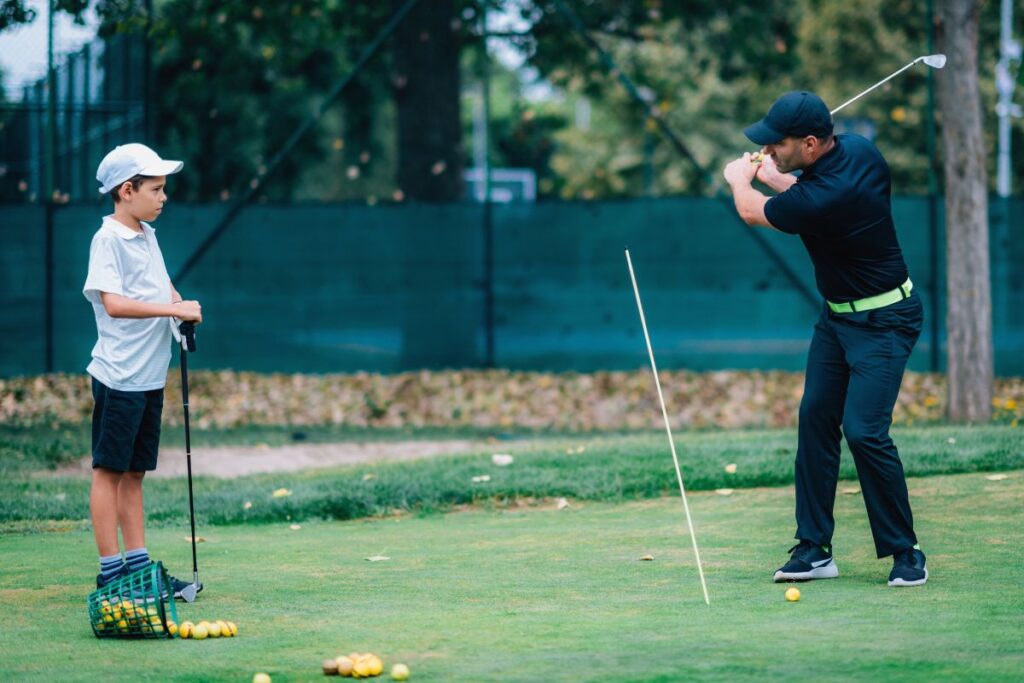Described as an “all arms” swing, a golf swing is characterized by movements primarily confined to the arms, with minimal engagement of the hips. In fact, this swing flaw neglects the involvement of the hips, often to a significant degree.
This stands in stark opposition to a more effective swing, which incorporates a substantial contribution from the hips and shoulders.
This dynamic swing involves a balanced coiling of the hips and shoulders during the backswing, followed by a coordinated uncoiling during the downswing.
By contrast, the “all arms” approach limits the rotational power potential and diminishes the overall fluidity of the swing, ultimately hindering the golfer’s performance.
To achieve a successful swing, a harmonious synergy between the arms, hips, and shoulders is crucial, generating both power and precision throughout the entire motion.
Table of Contents
Issues Linked with an Exclusively Arm-Centric Golf Swing
1. Not Enough Power & Distance
The primary drawback associated with relying solely on an arm-driven swing is its inability to generate significant power.
Instead of effectively harnessing and accumulating power during the coiling of the hips in the backswing, the neglect of hip engagement severely restricts the potential energy that can be effectively transferred to the golf ball upon impact.
This deficiency not only diminishes the force behind the shot but also hampers the overall distance and accuracy achievable. A well-executed swing should maximize the synergy between the arms and hips, allowing for a seamless transfer of energy, resulting in more powerful and precise shots that can significantly enhance a golfer’s performance on the course.
As a result, you might end up using a longer club than you really need for your next shot, or hitting shots onto the greens with a club that’s too long.
2. Not timing your shots properly can result in shots spreading out widely
Lazy engagement of your hips can also lead to issues with timing. This situation arises when you involve your hips in one part of the swing but not in another.
For instance, you might have coiled your hips during the backswing but are solely relying on your arm motion during the downswing.
Neglecting to bring your hips back into play before impact can disrupt the entire synchronicity of your swing, causing it to become disorganized and chaotic.
On the other hand, if you fail to properly coil your hips during the backswing but initiate a correct uncoiling of your hips during the downswing, the consequence will be misalignment of your hips at impact.
This misalignment will result in unpredictable shots with a wide distribution. Consequently, your shots will lack consistency, and their trajectory will scatter unpredictably across the target area.
Maintaining a harmonious connection between your hips and the rest of your swing is pivotal to achieving a more controlled and accurate golf game.
How to Break the Habit of Using Only Your Arms in Your Swing
1. Remember to Turn Your Upper Body
Engaging your upper body is crucial to address the limitations of an all-arms swing. As implied by the swing error’s name, this approach predominantly relies on arm movement to strike the ball, resulting in a lack of power and insufficient distance.
To ensure a more comprehensive involvement of your entire body in your golf swing, practice the following drill:
Position the club in front of your chest, with your hands gripping it, ensuring that the grip end points directly ahead toward the target.
Simulate a mock backswing, paying attention to the end of the club pointing at the ball when you reach the imaginary top of your swing.
Achieving this position necessitates the rotation of your upper body atop your hips, where your shoulders, rather than your arms, take on the primary role.
By embracing this technique, you’ll be able to generate effortless power, in stark contrast to the powerless exertion resulting from relying solely on your arms.
This holistic body involvement will not only enhance your swing’s efficiency but also contribute to more substantial distance and improved overall performance.
2. Direct Your Attention to Shifting Weight
Pay attention to involving your hips more in the swing, not just relying on your arms.
To help avoid the problem of using only your arms, try getting your hips moving early in the swing. This can help fix about half of the issue with an all-arms swing.
Making sure your weight shifts correctly during the backswing is important. If your hips rotate properly, your weight will move to your back foot. If they don’t, your weight will stay evenly balanced between both feet at the top of the swing.
After shifting your weight to the back foot, focus on moving it to your front foot as you swing down to hit the ball. This works best when your hips are moving and not staying back where they were at the top of the swing.
Tips from PGA coach Heather King
Many students encounter difficulty in fully elevating the club during their swing while maintaining the stability of their lead arm.
This issue commonly arises due to improper rotation in their golf technique, resulting in an overreliance on arm movement to reach the peak of the swing and causing strain on the lead arm.
A highly effective method to develop the correct sensation for the pinnacle of the golf swing involves lifting the club and resting it on your shoulders.
Proceed to execute a proper hip rotation until your back is oriented towards the target, followed by extending your arms away from your body and initiating the swing.
This approach aids in instilling the appropriate rotational mechanics within your body. As a result, not only will the over-reliance on arm movement diminish, but it will also facilitate the generation of greater power from the lower body.
How To Fix Swing Path
Starting your backswing correctly plays a big role in getting your drives to go where you want them to. Here’s a simple way to practice it:
Place a foam roller or a stick on the ground, running parallel to where you want the ball to go. Put a golf ball about an inch away from the roller. Stand in front of the ball, point your club towards the target, and set your feet parallel to the roller. This helps you see if you’re aiming right and swinging in the right direction.
Now, go ahead and start your swing. If your movement goes too much from inside to outside, you’ll hit the inner part of the foam roller. If it goes too much from outside to inside, you’ll strike the outer edge of the roller. Both of these swings can lead to inconsistent contact with the ball and problems with the direction it goes.
Remember, the roller is there to help you see how your swing is working, not to intimidate you. Think of it as a guide for your swing. Your aim is to keep the clubhead level with the roller or stick as you begin your swing. Keep your hands close to your body as you move the club along the foam roller (which represents the line you want the ball to go). You’re on the right track if you feel your left arm swinging across your chest with the club more in front of you.
As you finish your swing, smoothly turn your body all the way. If you miss the roller or stick, that’s a sign your swing is getting back on the right path.
Golf Swing Tips: More Power And Distance
To achieve greater distance in your swing, the important factor is allowing your swing motion to be guided by your arms, wrists, and hands, rather than relying on your hips and torso. By maintaining relaxed arms and enabling your hands and wrists to direct your body’s movement and path, you can achieve improved impact and generate increased power in your swing.
Professional golfer and Wilson Advisory Staff Member, Padraig Harrington, demonstrates a straightforward drill and technique that focuses on empowering your arms to drive your swing, resulting in enhanced power and extended distance.



